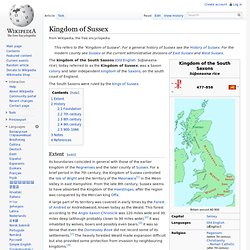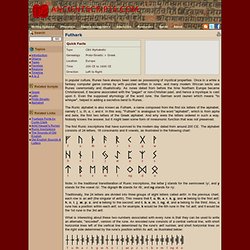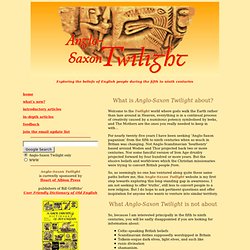

The Animated Bayeux Tapestry. Kingdom of Sussex. The kingdom of the South Saxons (Old English: Sūþseaxna rīce), today referred to as the Kingdom of Sussex, was a Saxon colony and later independent kingdom of the Saxons, on the south coast of England.

The South Saxons were ruled by the kings of Sussex. Extent[edit] Its boundaries coincided in general with those of the earlier kingdom of the Regnenses and the later county of Sussex. For a brief period in the 7th century, the Kingdom of Sussex controlled the Isle of Wight and the territory of the Meonwara[1] in the Meon Valley in east Hampshire. From the late 8th century, Sussex seems to have absorbed the Kingdom of the Haestingas, after the region was conquered by the Mercian king Offa. A large part of its territory was covered in early times by the Forest of Andred or Andredsweald, known today as the Weald. Futhark. In popular culture, Runes have always been seen as possessing of mystical properties.

Once in a while a fantasy computer game comes by with puzzles written in runes, and many modern Wiccan sects use Runes ceremonially and ritualistically. As runes dated from before the time Northern Europe became Christianized, it became associated with the "pagan" or non-Christian past, and hence a mystique is cast upon it.
Even the supposed etymology of the word rune, the German word raunen which means "to whisper", helped in adding a secretive bend to Runes. The Runic alphabet is also known as Futhark, a name composed from the first six letters of the alphabet, namely f, u, th, a, r, and k. In this way, "Futhark" is analogous to the word "alphabet", which is from alpha and beta, the first two letters of the Greek alphabet. The first Runic inscriptions that have survived to the modern day dated from around 200 CE. Origin Evolution and Variants of the Futhark Related Links. Anglo-Saxon Twilight. What is Anglo-Saxon Twilight about?

Welcome to the Twilight world where gods walk the Earth rather than laze around in Heaven, everything is in a continual process of creativity caused by a numinous potency symbolised by leeks, and The Mothers are the ones you really needed to keep in with… For nearly twenty-five years I have been seeking 'Anglo-Saxon paganism' from the fifth to ninth centuries when so much in Britian was changing. Not Anglo-Scandinavian 'heathenry' based around Woden and Thor projected back two or more centuries.
Nor some fanciful version of Iron Age druidry projected forward by four hundred or more years. But the elusive beliefs and worldviews which the Christian missionaries were trying to convert British people from. So, as seemingly no one has ventured along quite these same paths before me, this Anglo-Saxon Twilight website is my first step towards exploring this long-standing gap in awareness. What Anglo-Saxon Twilight is not about. Brian Bates - The Way of The Wyrd. York Coins. Anglo Saxon Books.